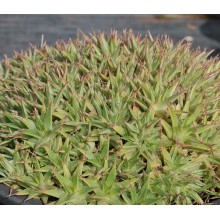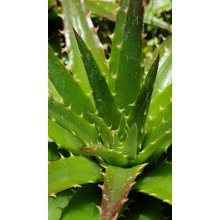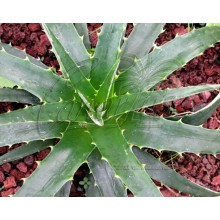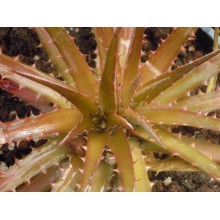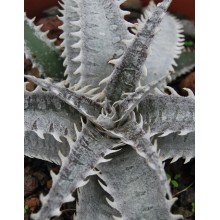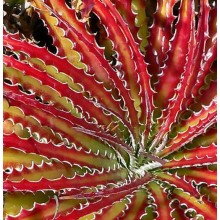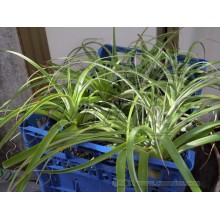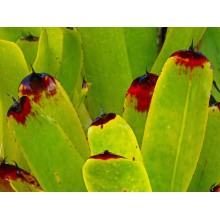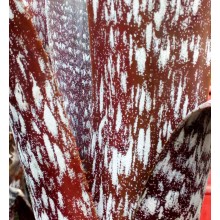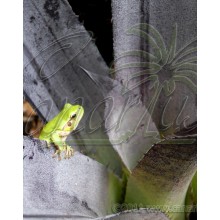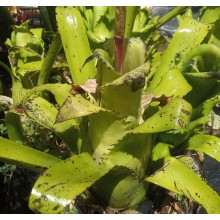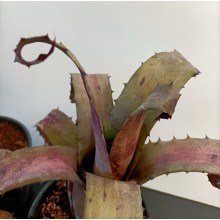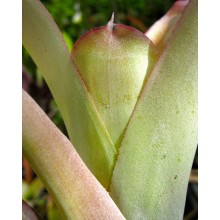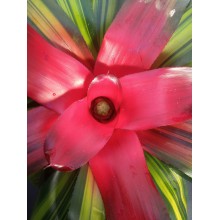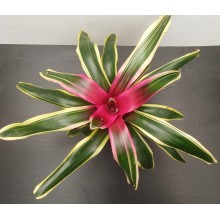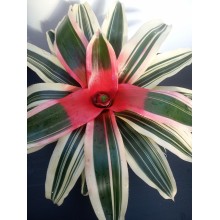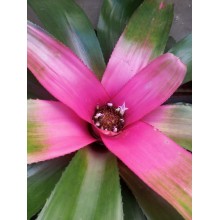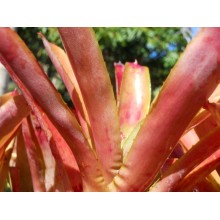Bromeliads There are 214 products.

Bromeliaceae is a large family of herbaceous plants native to the Americas. Just like many orchids, they naturally grow on tree branches or above rocks and cliffs. Bromeliads are highly appreciated because of their incredible colours and their ease of growth in pots.
We offer a fine selection of bromeliads that are never available through garden centres in Europe. Large scale distribution mostly sells green, thin-leaved hybrids. Our shop keeps an ever-increasing offer of the species with the toughest and most colourful leaves, better adapted to hot and cold conditions of outdoor life. All our bromeliads are shipped as bare root “pups”. These are the robust basal suckers produced after blooming. Bromeliads travel amazingly well in the mail and they are also cheap to ship. Our robust pups will often bloom in less than one year.
-
Dyckia encholirioides
Dyckia encholirioides
Glossy green, soft leaved succulent Dyckia. It is a variable species native to the coastal areas of Southern Brazil.
13,70 € 16,70 €Reduced price! -
Dyckia fosteriana rubra
Dyckia fosteriana rubra
This is a supreme clone of Dyckia fosteriana, with bronze coloured rosettes. It is a cold-resistant bromeliad from the rocky mountains of Paraná, in South Brazil.
19,50 € -
Dyckia x 'Avalanche'
Dyckia x 'Avalanche'
Showy silvery hybrid. Leaves are coated in furry trichomes, wide at the base and armed with large, white, recurved marginal spines. Highly ornamental and easy to grow!
42,00 € -
Guzmania conifera
Guzmania conifera
This large bromeliad has a spectacular inflorescence that extends above the cone-shaped leaves, hence its name 'conifer'.Its leaves are long and narrow and dark green in color.
28,30 € -
Hechtia texensis
Hechtia texensis
A small, colourful frost-hardy terrestrial bromeliad. A gem for collectors!
28,20 € -
Hechtia tillandsioides
Hechtia tillandsioides
This is an unusual and elegant terrestrial bromeliad with spineless silvery leaves. Leaves are soft and velvety to touch. Established plants will bloom with huge "sprays" of pink flowers. Hechtia tillandsioides is native to Mexico (States of Hidalgo and Mexico). It takes frost and feels at home in Mediterranean climates !
21,50 € -
Hohenbergia castellanosii
Hohenbergia castellanosii
Mid sized bromeliad from the coastal restingas in Bahia, with an upright crown of lime-green wide leaves, eventually tipped in red. Young plants are all green, slightly mottled and tips become more and more red when the plant gets larger, especially if a bit stressed for sun, or cold. Then most of the leaves turn purple-red when the plant blooms.
57,00 € -
Hohenbergia disjuncta
Hohenbergia disjuncta
Bromeliad with urn-like rosettes holding leaves with a tipically blunt leaf apex. This hohenbergia is endemic to Bahia and produces long, drooping inflorescences with grouped bract.
28,10 € -
Hohenbergia leopoldo-horstii
Hohenbergia leopoldo-horstii
A black plant! This outstanding bromeliad for collectors grows on hot rocky mountains in Bahia, Brazil. Rosettes are almost black. The leaf colour is very dark purple, coated with silvery fuzz but it turns really black with age.
42,50 € -
Hohenbergia leopoldo-horstii Green
Hohenbergia leopoldo-horstii Green
Hohenbergia leopoldo-horstii is an outstanding exotic for collectors described in 1991 from Bahia, in NE Brazil. This bromeliad grows on hot rocky mountains at about 1000 m elevation. In this green form, leaves are pale green with abundant silvery and purplish tones depending on the exposition.
32,00 € -
Hohenbergia magnispina
Hohenbergia magnispina
Magnificent magnispina! This bromeliad slowly builds sculptural clumps of huge rosettes of an unreal grey-purple colour. The leaves are very exotic and still very formal in shape. It is found in the Chiapada Diamantina of Bahia, Brazile.
43,00 € -
Hohenbergia penduliflora
Hohenbergia penduliflora
This Caribbean Hohenbergia has wide leaves that turn red in cool winters. Inflorescences are pendulous, ornamental, long-lived, ending up with white and blue fruits. It is endemic to Cuba and somehow cold-tolerant.
38,70 € -
Neoregelia 'Freddie'
Neoregelia 'Freddie'
Neoregelia 'Freddie' is a bromeliaceae with a cherry-red central foliage, green leaves with distinct white lines.
21,30 € -
Neoregelia 'Madame Van Durme Violet Center'
Neoregelia 'Madame Van Durme Violet Center'
A superb Bromeliad with very brightly coloured, green leaves with white margins.
21,30 € -
Neoregelia 'Madame Van Durme'
Neoregelia 'Madame Van Durme'
A superb Bromeliad with very brightly coloured, green leaves with white margins.
21,30 € -
Neoregelia 'Pink sensation'
Neoregelia 'Pink sensation'
Neoregelia 'Pink sensation', so called because of its striking shade of pink when flowering. This shade can last for several weeks.
21,30 € -
Neoregelia amandae
Neoregelia amandae
Small bromeliad with incredible changing colours. Leaves are thick and glossy, with some typical puckles on the base. Flowers are bright violet-blue. This plant came with no name but it eventually keyed out as Neoregelia amandae.
18,60 €
At the moment there are few products in this category Bromeliads
















